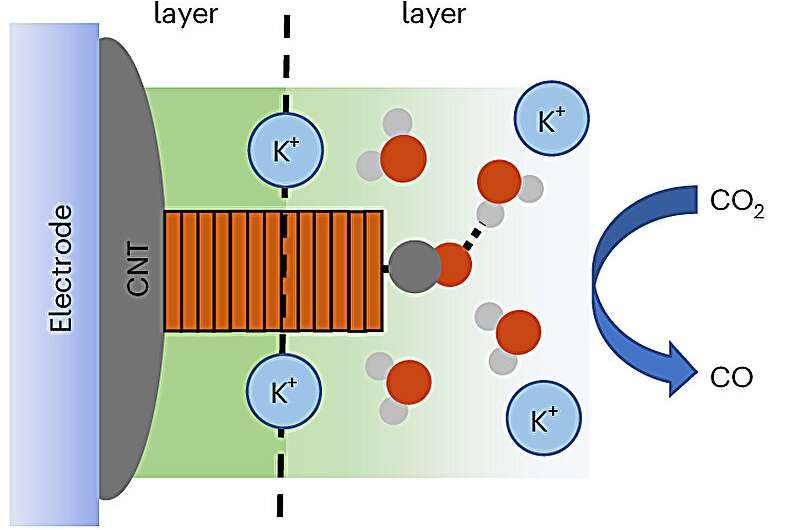This article has been reviewed according to Science X's editorial process and policies. Editors have highlighted the following attributes while ensuring the content's credibility:
fact-checked
peer-reviewed publication
trusted source
proofread
Chemists design novel method for generating sustainable fuel

Chemists have been working to synthesize high-value materials from waste molecules for years. Now, an international collaboration of scientists is exploring ways to use electricity to streamline the process.
In their study, published in Nature Catalysis, researchers demonstrated that carbon dioxide, a greenhouse gas, can be converted into a type of liquid fuel called methanol in a highly efficient manner.
This process happened by taking cobalt phthalocyanine (CoPc) molecules and spreading them evenly on carbon nanotubes, graphene-like tubes that have unique electrical properties. On their surface was an electrolyte solution, which, by running an electrical current through it, allowed CoPc molecules to take electrons and use them to turn carbon dioxide into methanol.
Using a special method based on in-situ spectroscopy to visualize the chemical reaction, researchers for the first time saw those molecules convert themselves into either methanol or carbon monoxide, which is not the desired product. They found that which path the reaction takes is decided by the environment where the carbon dioxide molecule reacts.
Tuning this environment by controlling how the CoPc catalyst was distributed on the carbon nanotube surface allowed carbon dioxide to be as much as eight times more likely to produce methanol, a discovery that could increase the efficiency of other catalytic processes and have a widespread impact on other fields, said Robert Baker, co-author of the study and a professor in chemistry and biochemistry at The Ohio State University.
"When you take carbon dioxide and convert it to another product, there are many different molecules you can make," he said. "Methanol is definitely one of the most desirable because it has such a high energy density and can be used directly as an alternative fuel."
While transforming waste molecules into useful products isn't a new phenomenon, until now, researchers have often been unable to watch how the reaction actually takes place, a crucial insight into being able to optimize and improve the process.
"We might empirically optimize how something works, but we don't really have an understanding of what makes it work, or what makes one catalyst work better than another catalyst," said Baker, who specializes in surface chemistry, the study of how chemical reactions change when they occur on the face of different objects. "These are very difficult things to answer."
But with the help of special techniques and computer modeling, the team has come significantly closer to grasping the complex process. In this study, researchers used a new type of vibrational spectroscopy, which allowed them to see how molecules behave on the surface, said Quansong Zhu, the lead author of the study and former Ohio State Presidential Scholar whose challenging measurements were vital to the discovery.
"We could tell by their vibrational signatures that it was the same molecule sitting in two different reaction environments," said Zhu. "We were able to correlate that one of those reaction environments was responsible for producing methanol, which is valuable liquid fuel."
According to the study, deeper analysis also found these molecules were directly interacting with supercharged particles called cations that enhanced the process of methanol formation.
More research is needed to learn more about what else these cations enable, but such a finding is key to achieving a more efficient way to create methanol, said Baker.
"We're seeing systems that are very important and learning things about them that have been wondered about for a long time," said Baker. "Understanding the unique chemistry that happens at a molecular level is really important to enabling these applications."
Besides being a low-cost fuel for vehicles like planes, cars and shipping boats, methanol produced from renewable electricity could also be utilized for heating and power generation, and to advance future chemical discoveries.
"There's a lot of exciting things that can come next based on what we've learned here, and some of that we're already starting to do together," said Baker. "The work is ongoing."
More information: Quansong Zhu et al, The solvation environment of molecularly dispersed cobalt phthalocyanine determines methanol selectivity during electrocatalytic CO2 reduction, Nature Catalysis (2024). DOI: 10.1038/s41929-024-01190-9
Journal information: Nature Catalysis
Provided by The Ohio State University




















